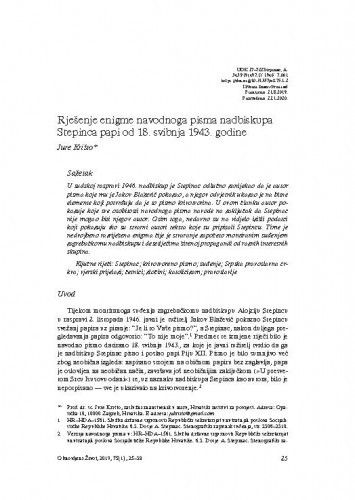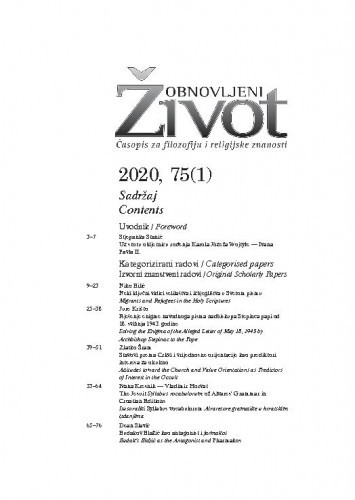U sudskoj raspravi 1946. nadbiskup je Stepinac odlučno zanijekao da je autor pisma koje mu je Jakov Blažević pokazao, a njegov odvjetnik ukazao je na bitne elemente koji potvrđuju da je to pismo krivotvorina. U ovom članku autor pokazuje koje sve osobitosti navodnoga pisma navode na zaključak da Stepinac nije mogao biti njegov autor. Osim toga, nedavno su na vidjelo izišli podatci koji pokazuju tko su stvarni autori teksta koje su pripisali Stepincu. Time je nedvojbeno razriješena enigma čije je stvaranje započeto montiranim suđenjem zagrebačkomu nadbiskupu i desetljećima širenoj propagandi od raznih interesnih skupina.; This article provides answers to the most important questions regarding Archbishop Stepinac’s alleged letter to the Pope, dated May 18, 1943. Although the Archbishop could easily agree with the general tendency of the letter, as it is a reflection of his judgments, he could not accept authorship thereof, because the letter simply was not his. In addition, the authors who considered the letter to be authentic were mistaken, further demonstrating the superficiality with which the documents and intricate historical circumstances were treated. The example of Jozo Tomasevich was singled out, who, on the basis of certain documents in the British archives, asserted the authenticity of Archbishop Stepinac’s alleged letter. His interpretation of the documents proved to be superficial and a product of ideological prejudice. The Communist authorities misused the letter by extracting from it what they thought could be used against Stepinac, which is the allegation that the Catholic Church would be in danger of losing 240,000 converts from Eastern Orthodoxy to Catholicism if the Croatian state were to collapse. However, after careful analysis of the actual contents of the letter, originally written in Italian, it proved to be a document of exceptional historiographical value. It is, in fact, a serious analysis of political and wartime circumstances, and of the consequences of ideas stemming from “Saint–Savism (svetosavlje)” and “Great–Serbianism“. The letter is, in fact, an expert analysis of the role of the Serbian Church in the events of World War II, and it is a prediction of the further fate of the Croats if the Greater Serbian Chetnik idea is to prevail. The essence of the Greater Serbian idea lies in its genocidal nature, for the realization of the idea involves the physical and spiritual destruction of other faiths and nations so as to erase them from the space that the idea envisions as being Serbian.
Sažetak

 Obnovljeni život : časopis za religioznu kulturu : 75, 1(2020) / glavni urednik Tadija Milikić.
Obnovljeni život : časopis za religioznu kulturu : 75, 1(2020) / glavni urednik Tadija Milikić.